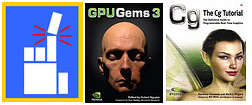this is the vertex shader:
Code: Select all
float3 fvLightPosition1;
float3 fvLightPosition2;
float3 fvEyePosition;
float4x4 matWorld;
float4x4 matWorldViewProjection;
float4x4 matWorldInverse;
struct VS_INPUT
{
float4 Position : POSITION0;
float2 Texcoord1 : TEXCOORD0;
float2 Texcoord2 : TEXCOORD1;
float3 Normal : NORMAL0;
float3 Binormal : BINORMAL0;
float3 Tangent : TANGENT0;
};
struct VS_OUTPUT
{
float4 Position : POSITION0;
float2 Texcoord1 : TEXCOORD0;
float2 Texcoord2 : TEXCOORD1;
float3 ViewDirection : TEXCOORD2;
float3 LightDirection1 : TEXCOORD3;
float3 LightDirection2 : TEXCOORD4;
float3 basis1 : TEXCOORD5;
float3 basis2 : TEXCOORD6;
float3 basis3 : TEXCOORD7;
float z : TEXCOORD8;
};
VS_OUTPUT vs_main( VS_INPUT IN )
{
VS_OUTPUT OUT;
OUT.Position = mul( IN.Position , matWorldViewProjection );
OUT.Texcoord1 = IN.Texcoord1;
OUT.Texcoord2 = IN.Texcoord2;
OUT.z=OUT.Position.z;
float3 RealPos = mul( IN.Position , matWorld);
float3 viewVec = fvEyePosition - RealPos;
float3 lightVec1 = fvLightPosition1 - RealPos;
float3 lightVec2 = fvLightPosition2 - RealPos;
float3 tViewVec;
float3 tLightVec1;
float3 tLightVec2;
float3 OTangent = normalize(IN.Tangent);
float3 ONormal = normalize(IN.Normal);
float3 OBinormal = cross( ONormal , OTangent );
OTangent = cross( OBinormal,ONormal );
float3 RTangent = mul( matWorldInverse , OTangent );
float3 RBinormal = mul( matWorldInverse , OBinormal );
float3 RNormal = mul( matWorldInverse , ONormal );
tViewVec.x = dot(viewVec,RTangent);
tViewVec.y = dot(viewVec,RBinormal);
tViewVec.z = dot(viewVec,RNormal);
tLightVec1.x = dot(lightVec1,RTangent);
tLightVec1.y = dot(lightVec1,RBinormal);
tLightVec1.z = dot(lightVec1,RNormal);
tLightVec2.x = dot(lightVec2,RTangent);
tLightVec2.y = dot(lightVec2,RBinormal);
tLightVec2.z = dot(lightVec2,RNormal);
OUT.ViewDirection = tViewVec;
OUT.LightDirection1 = tLightVec1;
OUT.LightDirection2 = tLightVec2;
OUT.basis1.x = OTangent.x;
OUT.basis1.y = OBinormal.x;
OUT.basis1.z = ONormal.x;
OUT.basis2.x = OTangent.y;
OUT.basis2.y = OBinormal.y;
OUT.basis2.z = ONormal.y;
OUT.basis3.x = OTangent.z;
OUT.basis3.y = OBinormal.z;
OUT.basis3.z = ONormal.z;
return( OUT );
}Code: Select all
float4 LightColor1;
float4 AmbientColor1;
float4 SpecularColor1;
float4 LightColor2;
float4 AmbientColor2;
float4 SpecularColor2;
float4x4 view_matrix;
float4 fogColor;
float near;
float far;
float density;
sampler2D baseMap;
sampler2D bumpMap;
sampler2D refMap;
sampler2D ShadowMap;
struct PS_INPUT
{
float2 Texcoord1 : TEXCOORD0;
float2 Texcoord2 : TEXCOORD1;
float3 ViewDirection : TEXCOORD2;
float3 LightDirection1: TEXCOORD3;
float3 LightDirection2: TEXCOORD4;
float3 basis1 : TEXCOORD4;
float3 basis2 : TEXCOORD5;
float3 basis3 : TEXCOORD6;
float z : TEXCOORD7;
};
float4 ps_main( PS_INPUT IN ) : COLOR0
{
float4 color=fogColor;
if(IN.z < far){
float ZDepth=min(max(near,IN.z),far);
float fog=((far-near)-(ZDepth-near))/(far-near);
fog=pow(fog,density);
float4 base = tex2D(baseMap,IN.Texcoord1);
float4 shadow = tex2D(ShadowMap,IN.Texcoord2);
base*=shadow;
float3 normal = tex2D(bumpMap,IN.Texcoord1);
normal = normal*2-1;
float3 viewDir = normalize(IN.ViewDirection);
float3 lightDir1 = normalize(IN.LightDirection1);
float3 lightDir2 = normalize(IN.LightDirection2);
normal = normalize(normal);
float3 halfView1 = normalize(lightDir1+viewDir);
float3 halfView2 = normalize(lightDir2+viewDir);
float specPower = 128*base.w;
float diffuse1 = dot(normal,lightDir1);
float specular1 = pow(saturate(dot(normal,halfView1)),specPower);
float diffuse2 = dot(normal,lightDir2);
float specular2 = pow(saturate(dot(normal,halfView2)),specPower);
float3 reflection=normal+1;
reflection.x= dot(normal,IN.basis1);
reflection.y= dot(normal,IN.basis2);
reflection.z= dot(normal,IN.basis3);
float3 refVec = mul(view_matrix,reflection);
refVec = normalize(refVec);
refVec = refVec+1;
refVec = normalize(refVec);
float fresnel = 1-pow(dot(normal,viewDir),16);
refVec.xy = refVec.xy*0.5 + 0.5;
float4 Reflection = tex2D(refMap,refVec.xy)*fresnel*base.w;
color = (saturate(AmbientColor1*base*0.25 + diffuse1*base*LightColor1 + specular1*base*SpecularColor1) +
saturate(AmbientColor2*base*0.25 + diffuse2*base*LightColor2 + specular2*base*SpecularColor2) +
Reflection)*fog + (1-fog)*color;
}
return ( color );
}



Any idea of what is out of place?


